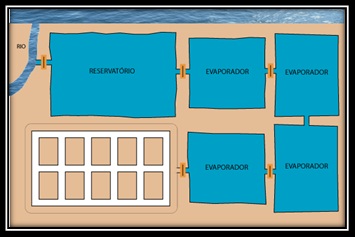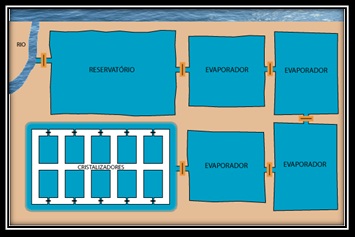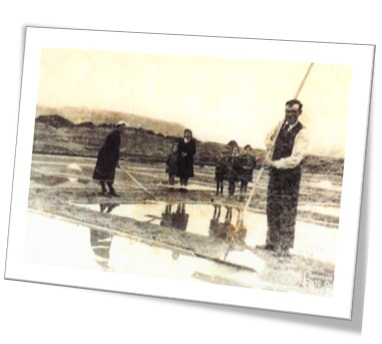Sal - Do mar à mesa EarthCache
-
Difficulty:
-

-
Terrain:
-

Size:  (other)
(other)
Please note Use of geocaching.com services is subject to the terms and conditions
in our disclaimer.
[PT]
Para logares responde por e-mail ás seguintes questões.
Após enviar o e-mail pode logar a earthcache. Caso seja necessário entrarei em contacto.
1 - Qual o tipo de extracção e de sal que encontras no GZ?
2 - Qual o aspecto da Flor de Sal?
3 - Qual a cor dos pilares que suportam o portão?
[EN]
To make a log, respond by e-mail to the following questions.
After you send the email you can log the EarthCache. If necessary I will contact you.
1 - What type of extraction and salt to find the GZ?
2 - What aspect (what it looks like) of Flower Salt?
3 - What is the color of the pillars that support the gate?
 [PT]
[PT]
Sal: Substância dura, solúvel, friável, seca, composta de cloreto de sódio, usada como tempero.
Existem dois tipos de extracção do famoso sal que conhecemos.
O sal de rocha ou sal-gema que é obtido de minas subterrâneas, resultantes da seca de antigas massas de água salgadas, tais como rios e lagoas, devido a alguma mutação geológica.
[EN]
Salt: hard substance soluble, friable dry, composed of sodium chloride used as a seasoning.
There are two types of extraction of the famous salt we know.
The rock salt that is obtained from underground mines, resulting from the dry ancient masses of salt water such as rivers and lakes, due to some geological change.
[PT]
E o sal marinho, sendo este constituído principalmente por cloreto de sódio, tem um sabor diferente do anteriormente descrito devido ao seu conteúdo mineral. Este tipo de sal é obtido pela evaporação da água do mar em salinas.
[EN]
And sea salt , which is composed primarily of sodium chloride, has a different taste of the previously described because of its mineral content. This type of salt is obtained by evaporation of sea water in salines.
 [PT]
[PT]
O processo de formação de sal começa com a entrada de água do mar num primeiro reservatório grande aquando das marés-altas, em que a água é melhor para a produção de sal. Este reservatório funciona como um grande lago onde a água fica armazenada.
[EN]
The salt formation process starts with the entry of sea water at a first large reservoir of high tides, in which the water is better for the production of salt. This reservoir serves as a great lake where the water is stored.
 [PT]
[PT]
De forma a obter águas com maior concentração de sal, são usadas salinas menos profundas para que a água se evapore melhor, quer sob o efeito do sol, quer sob o efeito do vento. Como as salinas são menos profundas, o sol aquece mais a água e portanto o processo de evaporação é acelerado. Por outro lado, as salinas são extensas de forma a beneficiar do efeito de concentração de sal provocado pelo vento sobre a superfície da água. As salinas usadas vão sendo cada vez menos profundas de forma a beneficiar da actuação do sol que vai aquecendo a água. Durante este processo, o grau de salinidade da água aumenta, quase ao ponto da cristalização.
[EN]
In order to obtain water with higher salt concentration, less profound salines are used for the water evaporate better or under the effect of sunlight or under the effect of wind. As the salines is less deep,the sun warms up the water and therefore the evaporation process is accelerated. The saline is extended in order to benefit from the effect of salt concentration caused by the wind on the water surface. The salines used will be less profound in order to benefit from the action of the sun that warms the water. During this process, the degree of salinity of the water increases, almost to the point of crystallisation.
 [PT]
[PT]
A água que se encontrava nas salinas anteriores é nesta fase do processo canalizada para as salinas de cristalização. Estas salinas constituem teias geométricas de salinas mais pequenas à volta das quais circula uma fonte comum de água salgada. São mais pequenas de modo a facilitar a colheita do sal que é realizada de forma manual através de longos ancinhos de madeira. É nesta fase que a flor de sal, é recolhida à superfície da água, através do uso de finas redes que normalmente se colocam na ponta de varas compridas. A flor de sal só pode ser recolhida quando o tempo assim o permite. Se existir demasiado vento os cristais vão ao fundo antes do salineiro ter tempo para os recolher.  O facto dos cristais de flor de sal estarem no início do seu processo de formação explica o seu aspecto de pequenos flocos e a sua finura. Estes cristais podem ser considerados as sementes que depois dão origem aos cristais mais grossos que se encontram na parte mais inferior das salinas.
O facto dos cristais de flor de sal estarem no início do seu processo de formação explica o seu aspecto de pequenos flocos e a sua finura. Estes cristais podem ser considerados as sementes que depois dão origem aos cristais mais grossos que se encontram na parte mais inferior das salinas.
Entre cada salina pequena existe uma berma que permite ao salineiro trabalhar entre as salinas e que funciona ainda como local para o sal recolhido ser drenado do excesso de água, antes de se passar à fase de armazenagem.
[EN]
The water of previous salines was in this stage is redirected to the crystallization salines. These salines are geometric webs of small saline, around which circulates a common source of salt water. These saline are smaller in order to facilitate the collection of salt which is carried out manually through long rakes timber. In this phase the flower salt is collected on the water surface, using thin networks that usually are placed at the end of long poles. The flower of salt can only be collected when the weather permits. If there is too much wind, the crystals go to the bottom before you have time to collect them.
The fact that the flower salt crystals are at the beginning of its formation process explains the aspect of small flakes and its fineness. These crystals can be considered after the seeds that give rise to crystals which are thicker in the lower part of the saline. Between each salt there is a small edge that allows the man to work between the saline and doubles as a place to be drained salt collected over water, before moving on to the stage of storage.
[PT]
O sal recolhido é colocado em forma de pirâmide nas bermas dos tanques onde fica a repousar de 2 a 3 dias. Neste processo, a maior parte da água contida no sal é escorrida para as salinas. No final desta fase, o sal está pronto para armazenamento ou para ser processado/embalado.
[EN]
The salt is collected in a pyramid placed at the edges of the tank where it is resting 2-3 days. In this process, most of the water contained in the salt is drained to the salinas. At the end of this phase, the salt is ready for storage or for processing / packed.
 [PT]
[PT]
O Sal Marinho tradicional que produzimos e comercializamos é inteiramente recolhido à mão, com o auxílio de instrumentos de madeira, segundo técnicas ancestrais que perduraram ao longo dos tempos. Resulta da conjugação harmoniosa do trabalho do salineiro com a acção das marés, do sol e dos ventos, e não é sujeito a nenhum tipo de tratamento posterior, apresentando-se naturalmente branco e brilhante.
[EN]
The Sea Salt traditional produce and sell is entirely hand-picked, with the aid of wooden instruments, according to ancient techniques that have survived over time. Results from the harmonious combination of man's labor with the action of the tides, the sun and wind, and is not subject to any further treatment, presenting naturally bright white.



Additional Hints
(No hints available.)